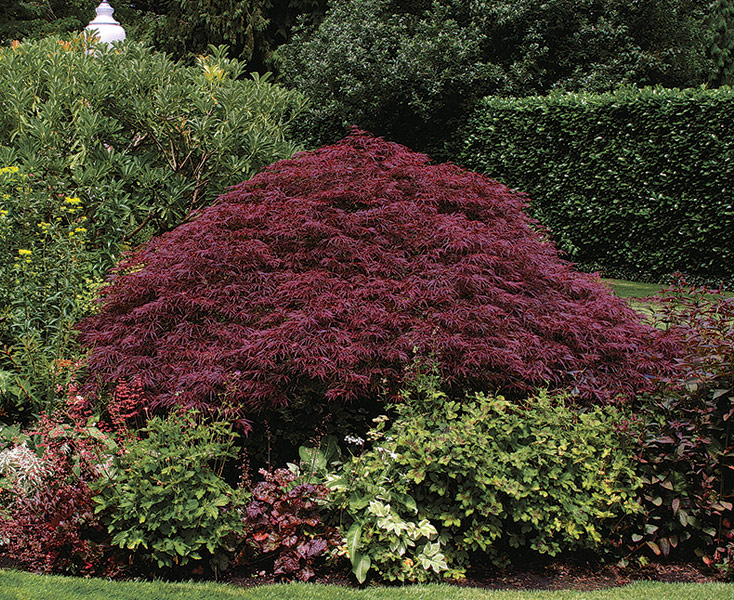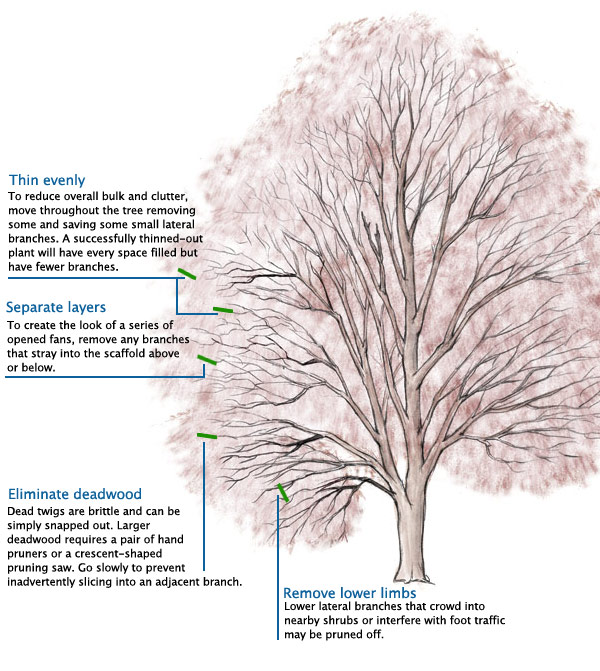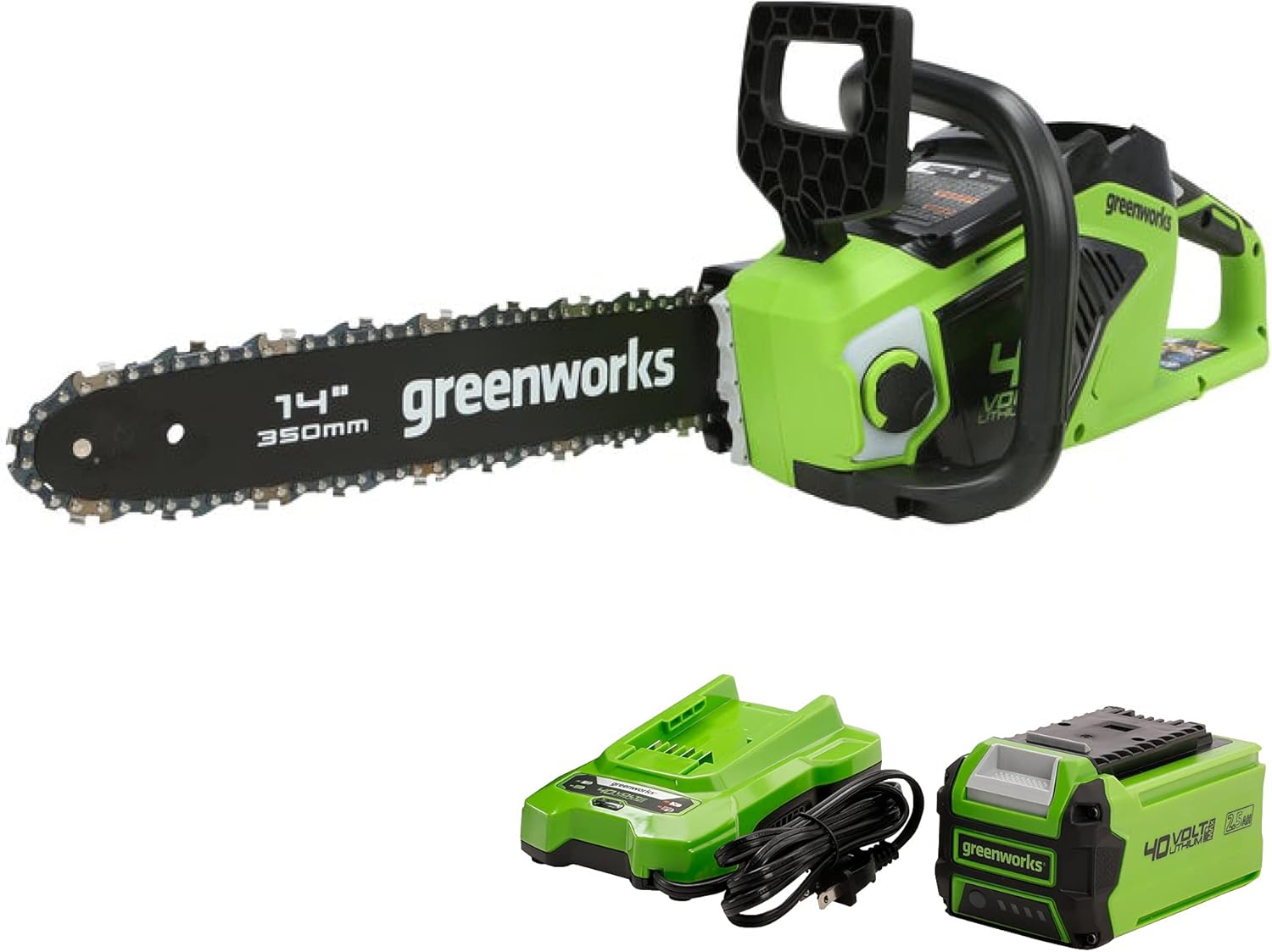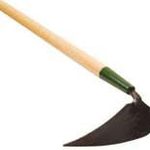Pruning Japanese Maples
The right cuts reveal a branch pattern that looks good with leaves or without

Japanese maples are elegant in all seasons, with delicate leaves, fine fall color, and the loveliest branch patterns in the world. The two most common forms of this tree are the upright, understory tree (Acer palmatum and cvs.) and its little brother, the Japanese laceleaf maple (Acer palmatum var. dissectum and cvs.), a much smaller, weeping tree often used as a garden focal point. When planted in the sun, as opposed to a partly shaded understory, these trees become fully foliated rather than open and airy. Some simple pruning can restore or enhance their natural form, bringing the most out of them for summer and winter viewing.
Learn more: Potential Sources of Trouble for Your Japanese Maple
Japanese maples less than 15 years old are prone to put on new growth that looks like a buggy whip: unattractively skinny with no side branches. This problem is exacerbated by pruning, often done by the impatient tree owner hoping to create an open look sooner than nature intended. Shortening or removing the buggy whips only stimulates more of the same. My best advice is to leave the tree alone for as long as possible. You will be surprised to find that, as the whips age, they fatten up, develop lateral branches, and turn into nice-looking scaffold limbs. Trust me. Sit on your hands and wait to start the thinning process until after the tree has aged and developed some grace.
Another practice to avoid is attempting to restrict the height of a Japanese maple. It won’t work. The tree will simply grow faster with thin, unruly branches. The width of these trees, on the other hand, can be somewhat modified.
Further reading
Enchanting Japanese Maples
Timing isn’t everything

The old gardener’s adage is “Prune when the shears are sharp”—and in general this is true. If you prune selectively, almost anytime is the right time to prune a Japanese maple. With that said, these maples are most easily pruned in winter or summer.
With the leaves out of the way in winter, it is easy to see the branch structure and, in turn, make the right cuts. In summer, however, you can judge the right amount of thinning needed to see the tree’s bones. Summer pruning also stimulates less plant growth than winter pruning, so you can get away with a little more and the tree will stay thinned out longer. I avoid pruning when the temperature is 80°F or higher, especially when the plant is located in full sun. Removing foliage will expose the tree’s thin, previously shaded bark to the light, inviting sunscald.
To avoid causing stress or stimulating unsightly growth, never remove more than one-fifth of a Japanese maple’s crown; you should also not prune a branch that is more than half the diameter of the parent stem. In addition, don’t remove more than a quarter of the foliage of any given branch. Each branch is fed by its leaves through photosynthesis. Removing too much of the foliage will starve the tree of nutrients.
If you prune selectively, almost anytime is the right time to prune a Japanese maple.
If you are going to “limb up” your tree by pruning the lowest branches, avoid stress to the plant by removing only a few at a time, not many at once. Never make one cut directly above another or opposite another limb being pruned off in the same year. That might cause decay to coalesce inside the trunk.
The trick to making Japanese maples look great is to separate the branches into overlapping layers that don’t touch each other. Most single-stemmed plants have a series of scaffold branches that radiate in a roughly spiral fashion up the trunk. If a lateral branch from any of these scaffolds grows downward, crossing into the layer below, it should be removed or cut back to a side branch facing up and out. This is how the tree becomes layered, like a series of fans.
While the average tree can handle light pruning, all cuts wound a plant. If your maple is in poor health, make minimal cuts or limit yourself to deadwood removal. To be extra kind, avoid pruning during the tree’s low-energy times: just as leaves emerge in the spring or when leaves are dropping in the fall (just two weeks in each case).
Upright Japanese maples

When pruning a Japanese maple, cut up to—but not into—the branch collar. If you cut too far out, you will leave an unsightly stub. If you cut too close to the parent stem (a flush cut), a column of rot will enter the stem. To minimize stress, dieback, and regrowth, do not remove a side branch that exceeds half the diameter of the parent stem.
You can’t change their nature
Some Japanese maples do not have especially graceful branches, possessing instead a twiggy or stiff-looking internal structure. Pruning cannot change the essential character of these trees. The wise gardener learns to appreciate plants for their own attributes and remembers that a good pruner can only reveal beauty, not create it.
Laceleaf Japanese maples

Many gardeners are so intimidated by this tree’s fragile branch structure that they don’t prune it at all, letting Japanese maples turn into mounds of foliage that resemble Cousin It. Others use such a heavy hand that they wind up with a little ball of foliage on the end of a stick. Laceleaf-maple pruning is often called “shell pruning” because when done correctly, the top layer of branches forms a protective veil of foliage over the plant that resembles a shell. Because the bones of this tree are important to its overall beauty, you’ll want to keep many of the unique, twisting branches intact.
Fine Gardening Recommended Products

Fine Gardening receives a commission for items purchased through links on this site, including Amazon Associates and other affiliate advertising programs.

Greenworks 40V 14" Chainsaw, 2.5Ah USB Battery and Charger Included
Fine Gardening receives a commission for items purchased through links on this site, including Amazon Associates and other affiliate advertising programs.

Long Handle EZ-Digger
Fine Gardening receives a commission for items purchased through links on this site, including Amazon Associates and other affiliate advertising programs.






Comments
I bought a Japanese maple last year and it hasn't done anything this year except at the very bottom of the trunk, there are little leaves forming. Should I cut the tree down to just above where the leaves are?
No, you cannot prune a JM as you might a prune a shrub. You do not say if your tree is in a pot or in the ground. If it is sprouting only (or mostly) at the base, then it is having issues at the roots and this should be corrected as soon as possible to save your tree. It should properly be repotted, or replanted. Take care doing this at the right time; Japanese Maples are sensitive to transplanting. Please Google potting and planting trees to get a thorough overview first of what to do, and what not to do.
There's a good chance your tree is grafted, so any branches coming from below the graft were from the rootstock, not the "pretty" part. Look up pictures of grafts, and if that's the case, remove all branches from below the graft so energy can be directed to the upper parts
I have had a Japanese maple for around 15 years or so.....This year 2/3 of tree look like has died and the other third is full leaved......On main trunk, the are little sprouts of new leaves coming out.......What is probability of survival? Or what could be done to help
I've seen that and it's hit or miss on survival. However the live part will probably be fine the rest of the season but maybe not the next. My research found that it may be Verticillium Wilt and some say that there is nothing you can do about it. Cut the dead out and remove those branches from the area and cross your fingers that it doesn't continue the next season. If it does kill the tree don't replace with another maple as it will likely infect that one as well.
My Gardner hacked my Japanese maple so much that now the new growth is looking like puff balls of leaves. What should I do to correct this?
It would be helpful to get this book on Japanese Maple tree as well. It has a wealth of information on caring and cultivation.
We've got a japanese maple where we just moved, it's been there for years since the previous owner died and the garden's overgrown/neglected. but I don't want to cut it back without knowing what I'm doing, so I'm reading this. But I'm still not sure, I think I'll have to get a book on it. I don't want to screw it up.
My red Japanese maple is about five years old and has always done beautifully without any fuss. This year we had a very late freeze here in Western Pennsylvania and the tips of the branches along with the leaves were frozen. I waited until there was a nice growth of new leaves on the tree (mid-June) and then snipped off the ugly little ends that had frozen. Did I harm the tree by doing this?
Why would my neighbor trim his Japanese Maple into shape of round ball? I have had several beautiful ones, including a cutleaf one and to me, they don't look right that way.(looks like a lollipop) Ball shaped. Is it because he is an anal engineer? They think differently that many people. I personally would never do that. Opinions?
"...you should also not prune a branch that is more than half the diameter of the parent stem. " Are you sure this is correct?
| really like this maples.
Log in or create an account to post a comment.
Sign up Log in